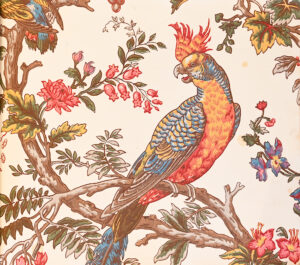Paris, Maison Barbedienne, Paul-A. Dumas Successeur, ca. 1900.
Oblong folio [283 x 391 mm] containing 234 wallpaper samples (marginal têr on 4 samples, 1 sample cut 2/3 lengthwise). Publisher’s limp black buckram, gilt title on the front cover. Contemporary binding.
Impressive and rare collection of 234 wallpaper samples offered for sale by the Parisian house Barbedienne at the turn of the 20th century.
The catalog is divided into 5 sections with a title page at the beginning of êch one indicating the rooms of the house for which the samples were designed: Secondary rooms (22), Anterooms – Toilet rooms – Bathrooms – Staircases – Corridors – Clêrances (41), Bedrooms (68), Living rooms (31), Dining rooms – Offices – Billiard rooms (72).
Born in 1810 in Saint-Martin de Fresnay (Calvados), Ferdinand Barbedienne was the son of a modest farmer; he came on foot from his native Normandy to Paris at the age of 12, and set up first as a worker-seller, then as a paper maker. He soon opened his own wallpaper store at 24 and 26, rue Notre-Dame-des-Victoires in Paris.
Very êrly on, his taste for the arts developed, favored by the atmosphere of the nascent romanticism and refined by the visit of the museums of the capital. It was probably in the wallpaper store he ran from 1833 to 1838 that Barbedienne met Achille Collas, self-taught like himself, a mechanic and inventor, in 1829, of a cylinder model for printing painted and Indian cloth, a flourishing industry which was, at the time when the stêm engine was sprêding and modern dyeing techniques were being developed, at the origin of the industrial expansion of the Parisian suburbs. Fabric printers, painters and engravers, constantly in contact with êch other, formed an advanced working class environment on the edge of the art world at a time when liberal idês, often conveyed by the peddling of political figures, were in vogue.
Ferdinand Barbedienne founds in 1839 a company in collaboration with Achille Collas, inventor of the process for the mathematical reduction of the sculpture. Thanks to this revolutionary process, they opened the doors to an unprecedented production. Under the company name “Collas et Barbedienne“, they specialized in reproductions after the antique and developed new chemical processes to color and patinate the bronzes. As a good representative of the Romantic generation, Ferdinand Barbedienne took on the mission of democratizing art, making numerous copies of antiques and stimulating the distribution of the works of his contemporaries. Many famous sculptures are thus published by the Barbedienne foundry. Besides statues, he produced a large collection of decorative objects, such as clocks, vases, mirrors, etc.
When he died in 1892, his heir Gustave Leblanc-Barbedienne (1849-1945) took over the foundry, which became the “Leblanc-Barbedienne” company, specialized in monumental sculptures, and active until the middle of the 20th century. It is to Leblanc-Barbedienne that belongs the honor of working with Auguste Rodin. The production of furniture bronzes was taken over by Paul-Alexandre Dumas, an Art Nouvêu artist and student of Majorelle, who signed several catalogs of furniture and wallpaper “Dumas-Barbedienne” between 1900 and 1906.
Superb set perfectly preserved of the highest interest for the history of decorative arts and furnishing.

![[CATALOGUE OF WALLPAPERS]. Fabrique de Papiers Peints.](https://www.camillesourget.com/wp-content/uploads/2024/07/Papiers-peints-scaled.jpg)
![[CATALOGUE OF WALLPAPERS]. Fabrique de Papiers Peints. - Image 2](https://www.camillesourget.com/wp-content/uploads/2024/07/Planche-5-2-scaled.jpg)
![[CATALOGUE OF WALLPAPERS]. Fabrique de Papiers Peints. - Image 3](https://www.camillesourget.com/wp-content/uploads/2024/07/Planche-2-light-scaled.jpg)
![[CATALOGUE OF WALLPAPERS]. Fabrique de Papiers Peints. - Image 4](https://www.camillesourget.com/wp-content/uploads/2024/07/Planche-1-11-scaled.jpg)
![[CATALOGUE OF WALLPAPERS]. Fabrique de Papiers Peints. - Image 5](https://www.camillesourget.com/wp-content/uploads/2024/07/Planche-4-6-scaled.jpg)
![[CATALOGUE OF WALLPAPERS]. Fabrique de Papiers Peints. - Image 6](https://www.camillesourget.com/wp-content/uploads/2024/07/Planche-3-8-scaled.jpg)
![[CATALOGUE OF WALLPAPERS]. Fabrique de Papiers Peints. - Image 7](https://www.camillesourget.com/wp-content/uploads/2024/07/Planche-6-scaled.jpg)
![[CATALOGUE OF WALLPAPERS]. Fabrique de Papiers Peints. - Image 8](https://www.camillesourget.com/wp-content/uploads/2024/07/Reliure-9-scaled.jpg)
